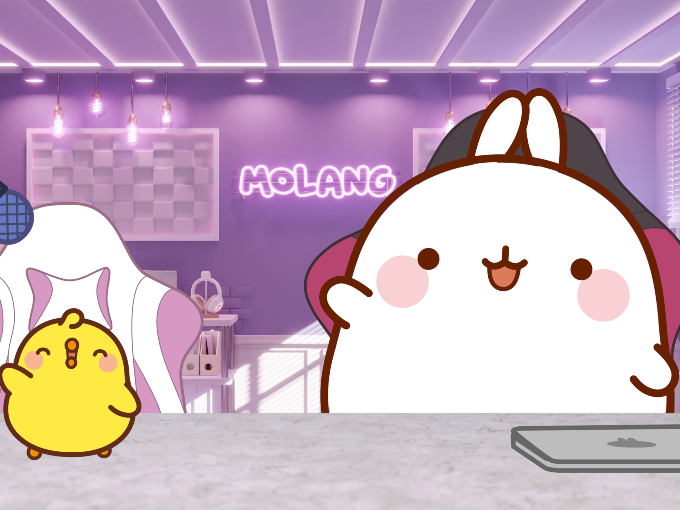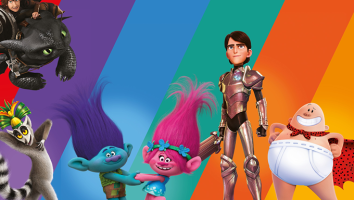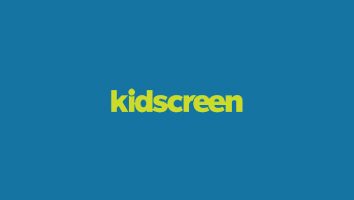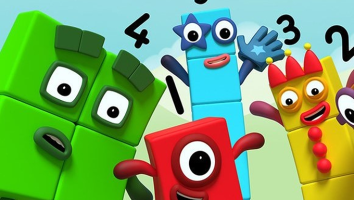It’s no secret that influencers are hugely popular with kids. In 2019, 28% of eight- to 12-year-olds who participated in a global survey conducted by The Harris Poll and The LEGO Group said they wanted to be YouTubers when they grow up. And in the US, more than half (54%) of 13- to 38-year- olds said they would become influencers if they could, according to another 2019 study from research firm Morning Consult.
Smelling an opportunity for brand expansion in all of this aspirational popularity, some kidcos are starting to position their animated characters as “virtual influencers” who function just like the real thing—and it’s already paying off in measurable results.
Molang, the YouTuber
In June 2023, French studio Millimages launched a YouTube-first series called Molang & Piu Piu YouTubers (pictured above, 26 x 10 minutes) that sees the bunny-and-chick duo making influencer-type videos in which they play video games, make ASMR sounds and answer questions from fans. It was budgeted at US$1 million, and took just eight months to produce.
A strong audience response to the first batch of episodes—which have generated more than six million views and 65,000 new subscribers for the show’s YouTube channel—has motivated Millimages to start planning a second season, says head of digital content strategy Kévin Maintrot. The studio is also looking to sell the series to traditional TV buyers and SVODs. Millimages identified that Molang fans tend to associate the brand with gaming, anime and K-pop, so it brought all of these elements into the new episodes, which will roll out in December 2023.
Storylines where the characters play video games seem to resonate the best, says Maintrot. But other influencer tropes the company is exploring for future content include personality tests, makeup videos and “try not to laugh” challenges in which the characters attempt to keep straight faces while watching funny clips.
Millimages had previously used YouTube primarily for sharing show clips and compilations, but when the reach of its Molang Cartoon channel hit more than 1.4 million subscribers, the timing seemed perfect to launch this new original series there, says Maintrot.
Molang & Piu Piu YouTubers is “blurring the line between animation and IRL,” he adds. “We have the opportunity to do collabs with other brands and sponsored content, and our goal is to gain 100,000 new channel subscribers by the end of the year.”
Going influencer-first
On the other end of the spectrum, LA’s Invisible Universe is taking a polar-opposite approach to developing virtual influencers. Its model is all about building its characters into stars on social media first, and then turning them into franchises.
The studio has successfully followed this blueprint to build an audience for characters such as Qai Qai (4.5 million TikTok followers)—a baby based on a doll belonging to tennis star Serena Williams’ daughter. And Grammy-winning songwriting duo Benj Pasek and Justin Paul created the character Ember (1.7 million TikTok followers)—a teen whose dad is the leader of a hellscape—in partnership with Invisible Universe, which also owns wholly original character brands like Lovie, a preschool IP with more than 200,000 YouTube subscribers.

Invisible Universe turning characters like Lovie into stars on TikTok and social media before turning them into franchises.
Now the company is ready to parlay these fandoms into new series, books and licensing deals.
In its videos, Invisible Universe’s characters answer questions from fans, talk about their lives and react to other creators’ videos. The studio can produce one- to two-minute influencer-style animated videos (with simple backgrounds and one character talking to the camera) in just two or three days, notes CEO Tricia Biggio.
This helps its characters stay current and on top of the newest trends—which is the key to success in the world of influencers, she adds. Now that it has built broad awareness for its character-driven brands across social media, Invisible Universe plans to use US$12 million raised in a funding round last year to move them beyond the world of influencers. To that end, it signed Segal Licensing as its first North American licensing agent in June.
The goal is to look at opportunities in television, consumer products, publishing and beyond. Invisible is currently developing and pitching a long-form Ember TV concept and chapter book series (both targeted at tween/teen girls), and in August it launched a YouTube series called Dance with Qai Qai, in which the character teaches kids how to groove. This new series is a prime example of how the company is monetizing brands as it works to expand them into every category on the franchise flywheel, says Biggio.
A whole new (virtual) world
Children’s television icons like Mister Rogers and Dora the Explorer have been breaking the fourth wall between kids and characters for decades by asking children questions on screen. But the next evolution of this dynamic is AI-powered characters who can actually hear what kids say and respond back, says Sonia Tiwari, a researcher at Penn State University who is focused on virtual influencers.
Embracing the intersecting trends of virtual influencers, AI and personalized content, California’s Inworld operates a platform where kids and brand owners alike can build chatbots capable of responding to both text inputs and kids’ voices, leading to more personal interactions.
The techco has already worked with Pokémon GO developer Niantic and South Korean telecom LG U+, and the educational characters they created together can be shared off-platform in their own channels and products, as well as integrated into kid-favorite hubs such as Roblox and Minecraft.
Inworld lets kids make their own characters free of charge—but it also offers a tech-supported enterprise tier that costs US$5,000 a month.
Clients of this service are largely using Inworld’s tools to make interactive video game characters, brand mascots and games. And the company is very keen to work with kids brand owners looking to add some interactivity to their characters, says marketing VP Monica Tran.
One company that is particularly interested in this approach is Disney, which selected Inworld for its accelerator program in 2022 to explore how the tech could be used in Disney’s storytelling. This experimentation yielded an online game prototype called Droid Maker, in which kids can make their own animated droids, ask them about Star Wars lore, and hear their thoughts on Disney’s galaxy far, far away. The media conglom is also developing an AI personality for Disney Star’s Indian metaverse platform Starverse, where kids can explore a 3D world that centers around sports.
“What we’re doing is creating characters with personality that have animation, and that feel like they’re part of the brand they represent,” says Tran. “Connecting with characters like these is an immersive and interactive experience that turns kids into co-creators and helps them form a deeper connection with the brands.”
This story originally appeared in Kidscreen‘s October/November 2023 magazine issue.



























